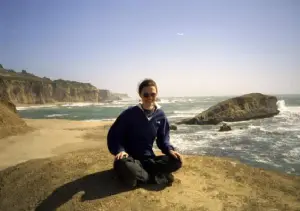
Theoretical Applied Ecology
office: 415A Mueller Laboratoryphone: +1 814-865-7910e-mail: k-shea@psu.edulab: 415 Mueller Laboratorylab phone: +1 814-865-7912Department web page
CIDD web page
I am in the Department of Biology but am also a faculty member of CIDD and of the IDGP in Ecology.
Research Interests:
My primary research interest is in the use of ecological theory in applied ecology and population management. I address issues in conservation, harvesting, epidemiology and the control of invasive species and epidemics. An in-depth ecological understanding is essential for successful management, and this research focus allows me to ask important ecological questions for species of special concern. For example, I address the ecological factors that make certain species successful invaders of specific communities, at the same time as examining the ways in which we can manipulate these factors to achieve management goals. My research focuses on population management in a variety of ways, including quantitative theoretical studies of real systems, purely theoretical studies that inform practical approaches, and empirical work.
Education:
- B.A. (Hons.) in Physics at New College, Oxford, UK (1990).
- Ph.D. in Theoretical Population Ecology at Imperial College, University of London, UK (1994).
- Postdoctoral Researcher on the factors affecting host-parasitoid population dynamics and stability at UC Santa Barbara (1994-96).
- Postdoctoral Fellow, Cooperative Research Centre for Weed Management, CSIRO, Australia, modeling the ecology and integrated management of invasive weeds (1996-99).
- Postdoctoral Researcher UC Santa Cruz, working on conservation strategies for endangered salmonids (1999-2000).
Selected Publications:
- Borchering, R.K.*, Viboud, C., Howerton, E., Shea, K., et al. (2021) Modeling of Future COVID-19 Cases, Hospitalizations, and Deaths, by Vaccination Rates and Nonpharmaceutical Intervention Scenarios — United States, April–September 2021. Morbidity and Mortal Weekly Report 2021;70:719–724. http://dx.doi.org/10.15585/mmwr.mm7019e3external icon.
- Li, S.-L., Ferrari, M.J., Bjørnstad, O.N., Runge, M.C., Fonnesbeck, C., Tildesley, M.J., Pannell, D., Shea, K. (2019) Concurrent assessment of epidemiological and operational uncertainties for optimal outbreak control: Ebola as a case study. Proceedings of the Royal Society B 286: 20190774. http://dx.doi.org/10.1098/rspb.2019.0774
- Probert, W.J.M., Jewell, C.P., Werkman, M., Fonnesbeck, C.J., Goto, Y., Runge, M.C., Sekiguchi, S., Shea, K., Keeling, M.J., Ferrari, M.J., and Tildesley, M.J. (2018) Real-time decision-making during emergency disease outbreaks. PLOS Computational Biology 14(7): e1006202. https://doi.org/10.1371/journal.pcbi.1006202
- Baker, C.M., Ferrari, M.J., Shea, K (2018) Beyond dose: Pulsed antibiotic treatment schedules can maintain individual benefit while reducing resistance. Scientific Reports 8: 5866. doi:10.1038/s41598-018-24006-w
- Li, S.-L., Bjørnstad, O.N., Ferrari, M.J., Mummah, R., Runge, M.C., Fonnesbeck, C., Tildesley, M.J., Probert, W.J.M., Shea, K. (2017) Essential information: Uncertainty and optimal control of Ebola outbreaks. Proceedings of the National Academy of Science. doi: 10.1073/pnas.1617482114. See http://www.pnas.org/content/early/2017/05/10/1617482114.abstract Press release at http://science.psu.edu/news-and-events/2017-news/Shea5-2017
- Milner-Gulland, E.J. and Shea, K. (2017) Embracing uncertainty in applied ecology. Journal of Applied Ecology. doi: 10.1111/1365-2664.12887.
- Shea K, Tildesley MJ, Runge MC, Fonnesbeck CJ, Ferrari MJ (2014) Adaptive Management and the Value of Information: Learning Via Intervention in
Epidemiology. PLoS Biol 12(10): e1001970. doi:10.1371/journal.pbio.1001970 - Teller, B.J., Campbell, C. and Shea, K. (2014) Dispersal under duress: can stress enhance performance of a passively dispersed species? Ecology 95(10): 2694-2698.
- Russo, L.A., Memmott, J., Montoya, D., Shea, K. and Buckley, Y.M. (2014) Patterns of introduced species interactions affect multiple aspects of network structure in plant-pollinator communities. Ecology 95(10): 2953-2963.
- Marchetto KM, Shea K, Kelly D, Groenteman R, Sezen, Z, Jongejans E (2014) Unrecognized impact of a biocontrol agent on the spread rate of an invasive thistle. Ecological Applications 24(5): 1178-1187.
- Garrison, A., Miller, A.D., Roxburgh, S. and Shea, K. (2012) More bang for the land manager’s buck: Disturbance autocorrelation can be used to achieve management objectives at no additional cost. Journal of Applied Ecology 49: 1020–1027
- Hall, A.R., Miller, A.D, Leggett, H.C., Roxburgh, S.H., Buckling, A. and Shea, K. (2012) Diversity–disturbance relationships: frequency and intensity interact. Biology Letters 8: 768-771.
- Campbell, C., Yang, Y., Albert, R. and Shea, K. (2011) A network model for plant-pollinator community assembly. Proceedings of the National Academy of Science 108(1): 197- 202.
- Miller, A.D., Roxburgh, S.H. and Shea, K. (2011) How frequency and intensity shape diversity-disturbance relationships. Proceedings of the National Academy of Science 108(14): 5643-5648.
- Shea, K., Jongejans, E., Skarpaas, O., Kelly, D., Sheppard, A. (2010) Optimal management strategies to control local population growth or population spread may not be the same. Ecological Applications 20(4): 1148-1161.
- Shea, K. (2007) How the Wood Moves. Science 315: 1231-1232.
- Skarpaas, O. and Shea, K. (2007) Dispersal patterns, dispersal mechanism and invasion wave speeds for Carduus thistles. American Naturalist 170(3): 421-430.
- Shea, K., Kelly, D., Sheppard, A. W. and Woodburn, T. L. (2005) Context-dependent biological control of an invasive thistle. Ecology 86: 3174-3181.
- Shea, K. and Chesson, P. (2002) Community ecology theory as a framework for biological invasions. Trends in Ecology and Evolution 17(4): 170-176.
Full publication list
Full CV
Researcher ID profile
Google Scholar profile
Please feel free to email me if you would like a copy of any of these papers.
